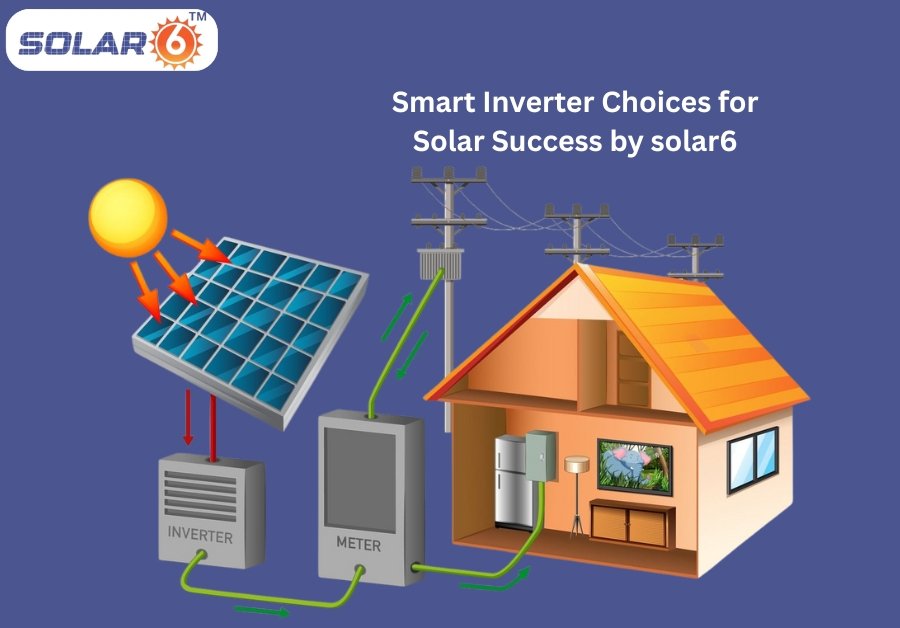When most people think reflect on going solar, their attention commonly turns to solar panels. But what many don’t recognise is that solar panels are handiest 1/2 the equation. The other half of—frequently disregarded but just as important—is the solar inverter. This crucial tool is accountable for converting the direct modern (DC) strength generated via your panels into the alternating cutting-edge (AC) that your home or business sincerely makes use of. Without a solar inverter, your solar device won’t characteristic.
Choosing the proper solar inverter is critical. It directly influences the efficiency, reliability, and return on investment of your sun set up. With the growing reputation of rooftop solar, the marketplace is full of inverter alternatives. From finance-friendly string inverters to high-tech hybrid and microinverters, making the right choice relies on your gadget size, finances, roof layout, and future energy dreams. In this article, solar6 discusses the Smart Inverter Choices for Solar Success.
Let’s discover the distinctive styles of solar inverters available and help you figure out which one is the quality fit for your desires.
Understanding the Role of a Solar Inverter
To position it truly, the solar inverter is the heart of your solar power system. Solar panels produce DC power; however, your property’s home equipment runs on AC. The inverter bridges this gap, ensuring the energy from your solar panels can be used efficiently. It moreover performs a key position in tracking device basic performance, protecting in opposition to faults, and dealing with grid interactions like net metering and battery storage.
A desirable inverter does not simply convert energy; it guarantees you get the maximum out of every ray of daylight.
Types of Solar Inverters
There are four most important types of solar inverters available nowadays. Each has its very own strengths and boundaries, relying on your private home, budget, and strength desires.
1. String Inverters (Central Inverters):
These are the most common types of inverters. In this setup, a group of solar panels—called a “string”—is connected to a single inverter, typically installed near your switchboard. String inverters are price-powerful, simple to install, and perfect for rooftops with complete sun exposure and uniform panel layout. However, the disadvantage is that if one panel inside the string underperforms (due to dust or colour), the whole string’s performance drops.
2. Microinverters:
Microinverters are installed on the returned of every solar panel. This approach allows each panel to operate independently, which is a massive advantage for roofs with shading issues, complex layouts, or panels dealing with more than one direction. Although they may be greater expensive initially, they deliver the most energy output and panel-stage tracking, making them a smart long-term investment for many homeowners.
3. Power Optimizers (with String Inverter):
Power optimizers work as a middle-ground solution. Each panel is paired with an optimizer that conditions the power before sending it to a centralized string inverter. This gives some of the advantages of microinverters (including handling shading more effectively) at a lower price, while nonetheless relying on a principal inverter for conversion.
4. Hybrid Inverters (Battery-Ready):
If you’re making plans to add battery storage either now or in the future, a hybrid inverter is the high-quality choice. It integrates solar panel input, battery storage, and even grid strength into one shrewd device. Hybrid inverters are becoming increasingly more famous for power independence and backup power solutions.
What to Look for When Buying a Solar Inverter
The proper inverter for your gadget needs to be tailored for your roof space, strength utilization, budget, and long-term power goals. Here are key factors to keep in mind earlier than you purchase:
1. Power Rating & Compatibility:
Your inverter should match your solar panel capacity. Installing an inverter that’s too large or too small for your system can lead to efficiency losses. Work with a certified installer who can recommend the right size based on your system design.
2. Inverter Efficiency:
Inverter efficiency is the percentage of solar power converted into usable electricity. Modern inverters usually have efficiencies of 95% or higher. Look for a model with high efficiency and good performance in partial load conditions.
3. Monitoring Features:
Today’s inverters frequently include mobile apps or net portals that let you tune power production, panel performance, and system health. This information facilitates your speedy discovery and prevents troubles, improving system uptime and overall performance.
4. Warranty and Support:
An accurate warranty is a reflection ofthe construct first-rate construction. Most inverters include 5 to ten years of warranty, with a few extending up to 15 or twenty years. Choose a brand with strong after-income guide and clean get admission to to provider facilities.
5. Compliance and Safety:
Always buy an inverter that’s certified by way of BIS (India) or global requirements like IEC, UL, and many others. This ensures protection, compatibility, and eligibility for authorities ‘ subsidies.
Top Solar Inverter Brands in India
Some of the most dependable and green solar inverter manufacturers to be had in India include:
Fronius – Known for quality and innovation.
Sungrow – Affordable and widely used across residential projects.
SMA Solar – Premium German engineering with robust features
Growatt – Reliable for both homes and commercial use
GoodWe – Excellent hybrid inverter options
Delta – Strong performance in Indian climates
Before finalizing an emblem, constantly check patron evaluations, guarantee conditions, and availability of service facilities in your vicinity.
How Much Does a Solar Inverter Cost?
Inverter expenses vary depending on the type, size, and brand. Here’s a general estimate:
String Inverter (3–5kW): ₹25,000 – ₹60,000
Microinverters: ₹10,000 – ₹15,000 according to panel
Hybrid Inverters: ₹60,000 – ₹1,20,000
Power Optimizer Systems: ₹4,000 – ₹6,000 in step with panel (plus string inverter)
Installation, wiring, and additional additives will increase the cost. Consider the overall cost of ownership, now not just the prematurely fee.
When to Choose Which Inverter?
Every rooftop is special. Here’s a short tenet that will help you pick:
- If you have a large, unshaded roof, go with a string inverter for simplicity and financial savings.
- If you have shading issues or multi-directional panels, bear in mind microinverters or energy optimizers.
- If you’re making plans to put in a battery garage, hybrid inverters are your excellent wager.
- For business and commercial setups, centralized string inverters with monitoring are best.
Tips for Getting the Most from Your Inverter
- Schedule annual renovation to smooth the inverter and take a look at for dirt or overheating.
- Place your inverter in a well-ventilated, shaded vicinity to shield it from heat and moisture.
- Use remote monitoring to keep tabs on performance and spot any issues early.
- Invest in a surge protector to safeguard the inverter from voltage spikes during storms or outages.
Conclusion: Choose Smart, Live Bright
A solar inverter isn’t simply a piece of hardware—it is the beating heart of your solar device. Choosing the right inverter guarantees your panels perform at their nice, your bills are low, and your smooth strength journey is easy and strain-free.
Take it slow, do your studies, and seek advice from a certified solar installer earlier than making your selection. A smart inverter preference nowadays manner many years of green, easy energy for your home or business the next day. Solar6 is the best destination to install solar panelas for your lovely home.

